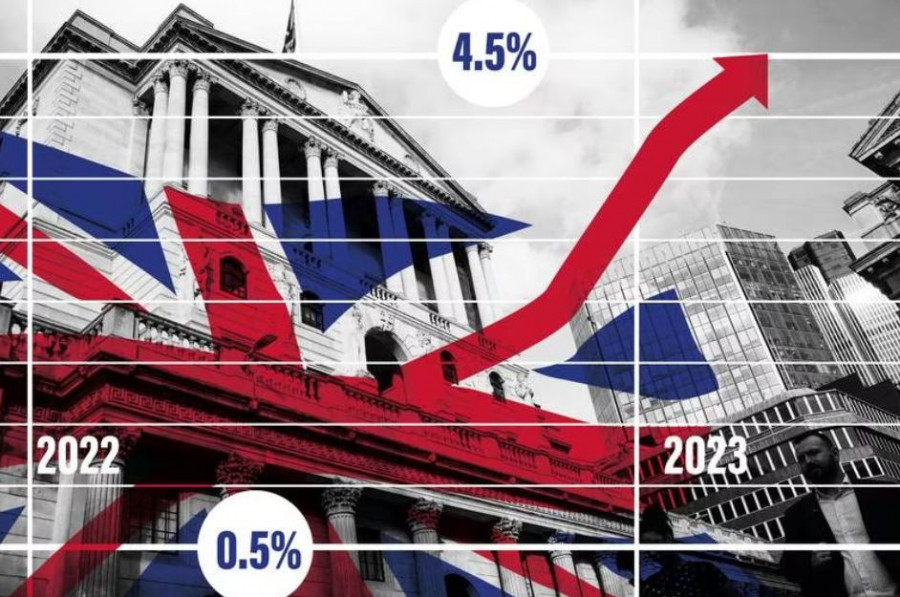
The Bank of England raised its interest rate by 25 points at the end of May meeting, which was the most expected, "base" scenario. Given the fact that this decision was actually factored into prices, traders focused on additional information, namely on the stance of the head of the British central bank and the wording of the accompanying statement.

In the end, the balance tipped against the pound, which came under pressure despite the hawkish result of the May meeting. The tone of the Bank's rhetoric was "final," so GBP/USD bulls found themselves in a stalemate: on one hand, the BoE's stance did not support the pound, on the other hand – the dollar strengthened, advancing amid growing risk-off sentiments.
The BoE is not an ally of the British currency
Recall that ahead of the May meeting, most experts had little doubt that the English central bank would raise the rate by 25 points. The reason for such confidence were the preceding macroeconomic releases, which reflected the growth of British inflation. For example, the Consumer Price Index has been above the psychologically important 10% mark for the seventh straight month. The core CPI, excluding food and energy prices, is also at an unacceptably (for the BoE) high level: contrary to forecasts of a decline to 6.0%, it remained at 6.2%. Other inflation indicators – the retail price index, the manufacturers' Purchase Price Index, and the manufacturers' selling price index – have also moved into the "green zone".
In addition, wages have also shown a positive dynamic: excluding bonuses, the average wage level increased to 6.6% year-on-year, including bonuses - to 5.9%. Both components were better than expected, reflecting the growth of inflationary indicators.
Such a result, one could say, "obliged" the Bank to take countermeasures to curb inflation in the country. The BoE did respond by raising the interest rate by 25 points, i.e., to 4.5%. But the market had already priced in this fact - back when the last inflation report was published. That's why traders were focused on the prospects for further tightening of monetary policy. But here the English central bank "got the ball rolling": the Bank's rhetoric was quite cautious, "final" in nature.
Central bank forecasts
In its final communique, the BoE, in particular, indicated that further tightening of monetary policy will only be needed if there are signs of more sustainable price pressures. Meanwhile, according to published forecasts, inflation will be 5.1% by the end of 2023, and by the end of next year – it will slow down to 2.3%. In addition, the Bank projected the growth of the country's economy this year - by 0.25%. Take note that the previous central bank forecasts implied a contraction of the British economy by 0.5%. In 2024, growth is expected to be 0.75% (while previously a decrease of 0.25% was forecasted). Commenting on inflation prospects, BoE Governor Andrew Bailey noted that there is every reason to believe that the CPI "will fall sharply from April". That is, the next inflation report should reflect a downward dynamic.
In other words, the BoE expects a significant reduction in inflation in the second half of the year with simultaneous economic growth (the forecast was revised for the better). At the same time, the central bank considers the next rate hike as an extraordinary event – if price pressure proves to be sustainable.
By the way, the UK GDP report matched forecasts, and some of its components even came out in the green zone. The country's GDP increased by 0.2% annually in the first quarter, after growing by 0.6% in the fourth quarter of 2022. Industrial production volume increased by 0.7% month-on-month in March (with a growth forecast of 0.1%) - this is the best result since May of last year. Another indicator showed a similar dynamic: the volume of production in the manufacturing industry (it increased by 0.7% with a forecast of 0.0%).
Back to the results of the BoE's May meeting, take note that the number of those who voted against the rate hike did not change: the ratio remained "7-0-2". Swati Dhingra and Silvana Tenreyro opposed additional monetary tightening, as in previous meetings.
Conclusions
The BoE did not support the pound. As a result of the May meeting, the Bank improved forecasts for the UK economy and predicted a significant slowdown in inflation. Against this background, the Bank made it clear that the next interest rate hike will only occur in case of further growth in inflationary indicators (this primarily concerns core inflation). At the same time, many experts (including Danske Bank) previously forecasted another rate hike in June, expecting the interest rate to reach its peak at 4.75%. Given the BoE's stance, we can assume that this scenario will only materialize in case of a significant increase in price pressure.
From a technical point of view, the pair is testing the support level of 1.2500 – at this price point, the middle line of the Bollinger Bands coincides with the Kijun-sen line on the daily chart. It would be wise to consider short positions once the bears consolidate below the specified target. In this case, the next target will be the 1.2350 mark – this is the lower Bollinger Bands line on the daily chart and at the same time the Tenkan-sen line – on the W1 timeframe.